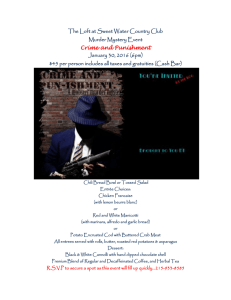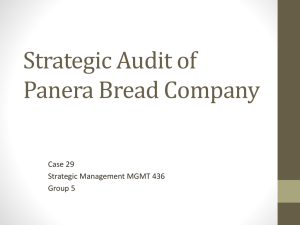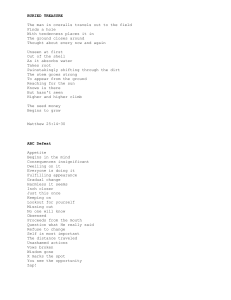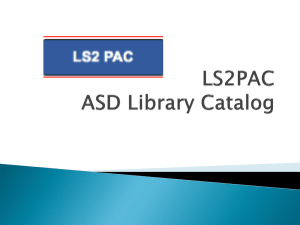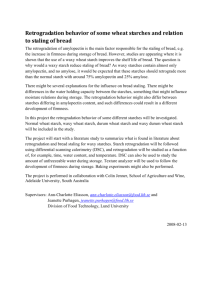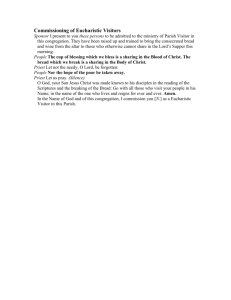retrogradation
advertisement
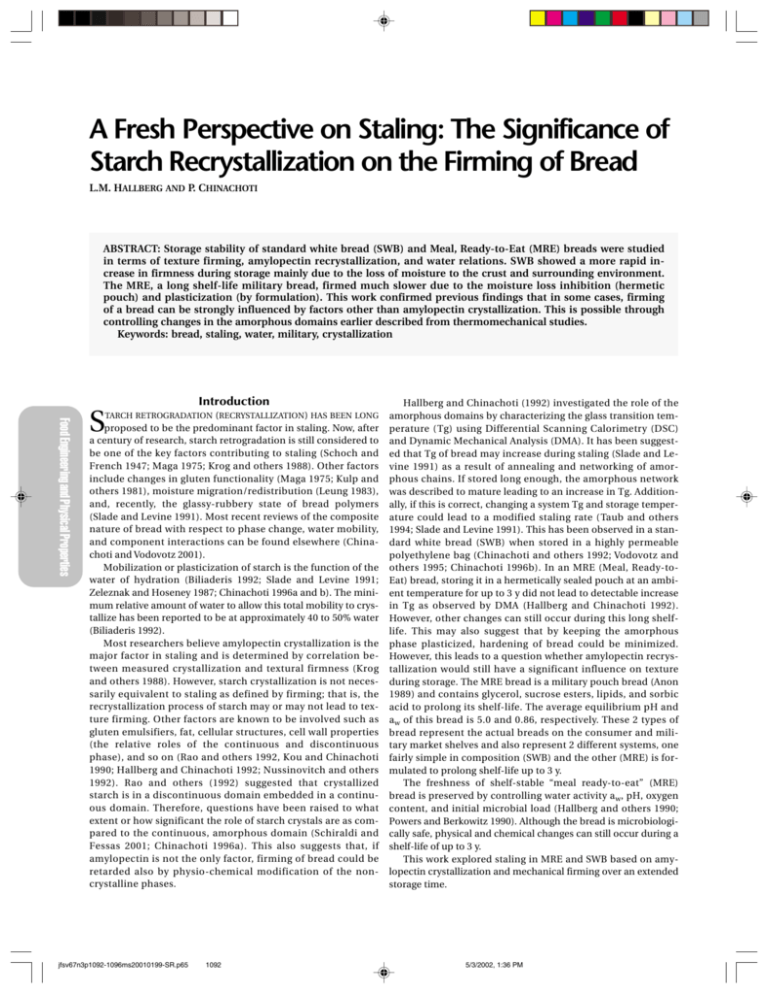
A Fresh Perspective on Staling: The Significance of Starch Recrystallization on the Firming of Bread L.M. HALLBERG AND P. CHINACHOTI ABSTRACT: Storage stability of standard white bread (SWB) and Meal, Ready-to-Eat (MRE) breads were studied in terms of texture firming, amylopectin recrystallization, and water relations. SWB showed a more rapid increase in firmness during storage mainly due to the loss of moisture to the crust and surrounding environment. The MRE, a long shelf-life military bread, firmed much slower due to the moisture loss inhibition (hermetic pouch) and plasticization (by formulation). This work confirmed previous findings that in some cases, firming of a bread can be strongly influenced by factors other than amylopectin crystallization. This is possible through controlling changes in the amorphous domains earlier described from thermomechanical studies. Keywords: bread, staling, water, military, crystallization Introduction Food Engineering and Physical Properties S TARCH RETROGRADATION (RECRYSTALLIZATION) HAS BEEN LONG proposed to be the predominant factor in staling. Now, after a century of research, starch retrogradation is still considered to be one of the key factors contributing to staling (Schoch and French 1947; Maga 1975; Krog and others 1988). Other factors include changes in gluten functionality (Maga 1975; Kulp and others 1981), moisture migration/redistribution (Leung 1983), and, recently, the glassy-rubbery state of bread polymers (Slade and Levine 1991). Most recent reviews of the composite nature of bread with respect to phase change, water mobility, and component interactions can be found elsewhere (Chinachoti and Vodovotz 2001). Mobilization or plasticization of starch is the function of the water of hydration (Biliaderis 1992; Slade and Levine 1991; Zeleznak and Hoseney 1987; Chinachoti 1996a and b). The minimum relative amount of water to allow this total mobility to crystallize has been reported to be at approximately 40 to 50% water (Biliaderis 1992). Most researchers believe amylopectin crystallization is the major factor in staling and is determined by correlation between measured crystallization and textural firmness (Krog and others 1988). However, starch crystallization is not necessarily equivalent to staling as defined by firming; that is, the recrystallization process of starch may or may not lead to texture firming. Other factors are known to be involved such as gluten emulsifiers, fat, cellular structures, cell wall properties (the relative roles of the continuous and discontinuous phase), and so on (Rao and others 1992, Kou and Chinachoti 1990; Hallberg and Chinachoti 1992; Nussinovitch and others 1992). Rao and others (1992) suggested that crystallized starch is in a discontinuous domain embedded in a continuous domain. Therefore, questions have been raised to what extent or how significant the role of starch crystals are as compared to the continuous, amorphous domain (Schiraldi and Fessas 2001; Chinachoti 1996a). This also suggests that, if amylopectin is not the only factor, firming of bread could be retarded also by physio-chemical modification of the noncrystalline phases. jfsv67n3p1092-1096ms20010199-SR.p65 1092 Hallberg and Chinachoti (1992) investigated the role of the amorphous domains by characterizing the glass transition temperature ( Tg) using Differential Scanning Calorimetry (DSC) and Dynamic Mechanical Analysis (DMA). It has been suggested that Tg of bread may increase during staling (Slade and Levine 1991) as a result of annealing and networking of amorphous chains. If stored long enough, the amorphous network was described to mature leading to an increase in Tg. Additionally, if this is correct, changing a system Tg and storage temperature could lead to a modified staling rate ( Taub and others 1994; Slade and Levine 1991). This has been observed in a standard white bread (SWB) when stored in a highly permeable polyethylene bag (Chinachoti and others 1992; Vodovotz and others 1995; Chinachoti 1996b). In an MRE (Meal, Ready-toEat) bread, storing it in a hermetically sealed pouch at an ambient temperature for up to 3 y did not lead to detectable increase in Tg as observed by DMA (Hallberg and Chinachoti 1992). However, other changes can still occur during this long shelflife. This may also suggest that by keeping the amorphous phase plasticized, hardening of bread could be minimized. However, this leads to a question whether amylopectin recrystallization would still have a significant influence on texture during storage. The MRE bread is a military pouch bread (Anon 1989) and contains glycerol, sucrose esters, lipids, and sorbic acid to prolong its shelf-life. The average equilibrium pH and a w of this bread is 5.0 and 0.86, respectively. These 2 types of bread represent the actual breads on the consumer and military market shelves and also represent 2 different systems, one fairly simple in composition (SWB) and the other (MRE) is formulated to prolong shelf-life up to 3 y. The freshness of shelf-stable “meal ready-to-eat” (MRE) bread is preserved by controlling water activity aw, pH, oxygen content, and initial microbial load (Hallberg and others 1990; Powers and Berkowitz 1990). Although the bread is microbiologically safe, physical and chemical changes can still occur during a shelf-life of up to 3 y. This work explored staling in MRE and SWB based on amylopectin crystallization and mechanical firming over an extended storage time. 5/3/2002, 1:36 PM Starch crystallization and bread staling . . . Bread preparation The formulas for the SWB and MRE breads are presented in Table 1 and 2, respectively. Both breads were processed using the straight dough method (modified procedures from Anon 1989, for MRE; and from Nussinovitch and others 1991, for SWB). Four 5 lb batches of dough were prepared for each type of bread. Each 5 lb batch made 10 loaves of bread. The dough content was dry mixed, hydrated, developed, and fermented (85 F at 80% RH) for approximately 2.5 h. It was then divided into 1.8 oz. (51 g) pieces, molded, proofed, (95 F or 32 C, 90% RH) until rising level with the top of the lidded pan (approximately 1 ¼ “ in height). The baking was done at 375 F (190 C) for 20 min. Both SWB and MRE breads were prepared in a similar fashion with a few exceptions. For the case of MRE bread, the dough needed less time (1 hr) than the SWB to ferment, since it did not have undissociated potassium sorbate that inhibits yeast growth. Additionally, the baking was done for 20 min at 330 F (166 C). The baked weights were 48 g and 45 g for MRE and SWB, respectively. The volume of the baked breads were approximately 2 ¼ 4 ½ 1 ¼ in3 as restricted by the pan lid. (The lid is to assure the fit of the breads in the pouch as required in the military ration package). The specific volume of the baked MRE and SWB breads were 0.0043 and 0.0046 m3/Kg, respectively. The breads were cooled (on racks in a clean, enclosed, proof box to limit the airflow and reduce the possibility of contamination) to less than 120 F, (but not less than 80 F) and then sealed intact in their respective packaging. MRE breads were hermetically sealed in trilaminated pouches (polyester, aluminum foil, and polyolefin; Cadillac Products Inc., Ill., U.S.A.) with a Multivac sealer (Koch Supplies, Inc., Kansas City, Mo., U.S.A.). SWB was sealed in 5 mil polyethylene bags, with a Cryovac film sealer (Koch x 200, Koch Supplies, Inc., Kansas City, Mo., U.S.A.). Both breads were sealed at ambient pressure, with a 50 g packet of oxygen scavenger (Fresh Pax, Multisorb Technologies, Buffalo, N.Y., U.S.A.) inserted to extend shelf-life. It should be noted that the SWB was additionally preserved by 0.1% potassium sorbate in the formula to prevent molding, since it had a higher moisture content. Four sets of 10 breads from each 5 lb batch were made for this study. The MRE bread samples were stored at 25 C and withdrawn at 0, 3, 6, 12, 17, 50, and 87 mo. SWB was withdrawn at 0, 3, 6, 7, and 17 mo, at which time mold became evident. Duplicate samples were withdrawn for DSC, Instron, and moisture measurements. Duplicate measurements were made and averaged. Samples for testing were taken from the geometric center of the crumb (to assure the most uniform moisture content). Thermal transitions by DSC Approximately 15 mg of bread crumbs were placed in a stainless steel, hermetic sample pan (Perking Elmer, Somerset, N.J., U.S.A.). The sample, along with an empty reference pan, was placed into the Differential Scanning Calorimeter (DSC) chamber and chilled with liquid nitrogen to –100 C. A gas purge of pure nitrogen gas flowed (30 ml / min) through the furnace chamber to eliminate any moisture in the head space (as found in preliminary results, not shown). The DSC (Seiko Instruments Int., model DSC 100, Torrence, Calif., U.S.A.) was calibrated using indium and programmed to heat the sample and empty reference pans from –100 C to 130 C at a rate of 10 C / min. Heat flow recorded in mW as plotted against temperature. Amylopectin crystallization was measured from an endother- jfsv67n3p1092-1096ms20010199-SR.p65 1093 Table 1—Standard white bread formula Ingredients % Flour Water Shortening Sugar Salt Yeast Calcium propionate Potassium sorbate TOTAL 57.5 34.5 3.0 2.7 1.0 1.0 0.2 0.1 100.00 mic melting enthalpy corresponding to a peak at 60 to 80 C range. It was calculated in terms of melting calories per gram of starch. This was done using the following conversion factors: cal 1 g sample 65.5 g solids SWB –———— ————— –————— g sample s g solids 57.5 g flour 100 g flour –––––———– 73.3 g starch cal 1 g sample 71.7 g solids MRE –———— ————— –————— g sample s g solids 50.3 g flour 100 g flour –––––———– 73.3 g starch Where s is g solids / g bread. This calculation was done using a starch content of 73.3% flour basis (Baik and Chinachoti 2000); both SWB and MRE breads contained the same type of flour. Texture measurement Compression testing was performed using an Instron Universal Machine (Canton, Mass., U.S.A.) according to Peleg and others (1989) and Nussinovitch and others (1992). Each sample was taken from the geometric center of each loaf in order to avoid the crust; samples with larger air voids were eliminated. The samples were cut into 50 mm dia discs with a thickness of 25 mm using a sharp cutter. Uniaxial compression was done at the crosshead speed of 10 mm / min and the containment cell of 50 mm diameter was used. Measurement was done immediately after samples were removed from the package to prevent excessive moisture loss before testing. Standard error was 3 Kpa. Moisture content determination Moisture content measurement was performed on each 10 g sample using vacuum oven methods (48 hours at 21 C, 30 in Hg vacuum, AOAC Method 1973). Results and Discussion Rheological characterization Sigmoidal compressive stress-strain behavior has been found in various types of bread (Peleg and others 1989; Swyngedau and others 1991; Nussinovitch and others 1991, 1992; Kou and Chinachoti 1990). The 3 parts to the typical curve- the shoulder, the plateau, and the vertical ascent- represent the matrix deformation, cell wall collapse, and the cell wall material densification, respectively. Nussinovitch and others (1992) and Kou and Chinachoti (1990) both characterized freshly made and staled white bread. Figure 1a and 1b shows the stress-strain relationship for MRE and SWB, respectively. Over storage time, both breads showed a 5/3/2002, 1:36 PM Food Engineering and Physical Properties Materials and Methods Starch crystallization and bread staling . . . Table 2—MRE bread formula Ingredients % Flour Water Shortening Glycerol Yeast Salt Sucrose ester Gum arabic Xanthan gum Calcium sulfate Sorbic acid TOTAL 50.3 28.9 8.5 6.3 2.3 1.3 1.0 0.5 0.5 0.3 0.1 100.00 Food Engineering and Physical Properties significant increase in firmness (stress) at a given strain. Note the difference in time periods between the 2 breads. After 82 mo, inspection revealed the package was intact. The sample was noticeably very firm to the touch even though moisture content was measured to be relatively unchanged (23%, total basis) and the package integrity was maintained. The stress-strain curve from MRE bread showed no prominent shoulder (Figure 1a). This was due to smaller air cells inherent to this type of bread, which resulted in a higher density. The SWB with full volume and large cells, after aging for 2 mo, however, had a distinct shoulder (Steffens 1992; Peleg and others 1989). Stress values at 30% deformation (Table 3) increased with storage. For MRE bread, the stress value increased to 18 kPa with the 1st 3 mo and remained relatively stable ( > 30 kPa) for 54 mo (beyond the expected shelf-life of 3 y). SWB deformation showed a relatively higher firmness than MRE bread staled. SWB stored for 3 mo was very firm and unacceptable while MRE bread at 3 to 15 mo of storage was still soft and more acceptable (Steffens 1992). Only after an extremely long period (47 and 82 mo or 4 to 7 y) did the MRE bread become “staled” or noticeably firm. The difference in firmness developed during aging of SWB and MRE bread could be caused by a number of factors. One of the obvious factors was the difference in the amount of moisture loss through the package. While MRE bread retained all moisture within the hermetically sealed pouch, a very significant amount of moisture was lost through SWB samples due to the highly permeable polyethylene bag. As shown in Table 3, SWB moisture content decreased from 43.8% to 32.0% moisture in 8 mo and to 17.8% moisture after 17 mo of storage. MRE bread, however, did not change significantly in moisture content (Table 3). Another factor could be the differences in composition and processing conditions between the 2 breads. MRE bread, for instance, contained a significant amount of glycerol (in addition to other ingredients) which is an effective plasticizer. Although the 2 breads were very different in composition, processing, and storage conditions, this exercise shows that firming of bread could be overcome during storage by modification of various parameters as employed in the case of MRE bread. 80 C. Subsequent runs at 1 to 50 mo produced similar-sized endotherms (that is, enthalpies of 0.38 0.13 to 0.46 0.08 cal / g sample, respectively). DSC data for this peak are shown in Table 3. Similar results were found for SWB. MRE bread showed an increased amylopectin crystallization within the 1st 3 mo of storage, and remained relatively constant thereafter. The temperature range of the transition (Table 3) was considerably higher than those values earlier reported for amylopectin in starch (Yuryev and others 1995) which could probably be due to the solutes present. Factors, such as moisture content, heating rate, sample size, and composition, might also contribute to the discrepancies. The initial and peak temperatures ( To and Tp, respectively) did not significantly change over time for MRE bread (Table 3). This was also the case for SWB except for the 17 mo sample when To and Tp increased due to the extensive moisture loss. Enthalpy of amylopectin crystal melting (0.71 0.14 cal / g starch) appeared to peak within the 1st 6 mo of storage for both cases (Table 3). Then, the values decreased slightly and leveled off for the remaining time of the study. SWB showed less amylopectin crystallinity. When compared the enthalpies for the 2 breads directly on a calorie per gram starch basis, the difference was more obvious (Table 3). This could be due to composition difference, an extensive moisture loss in SWB that retarded the recrystallization process. Moisture has been found to have a positive effect on crystallization of amylopectin (Chinachoti Amylopectin recrystallization DSC thermograms were obtained at up to 50 mo of storage. Fresh MRE bread did not display a starch melting endotherm (over 50 to 60 C range for amylopectin melting transition). After 6 mo of storage at 25 C, a small endotherm started to appear, (0.31 0.06, cal / g sample) at a temperature range of 60 C to jfsv67n3p1092-1096ms20010199-SR.p65 1094 Figure 1a&1b—Stress-strain curves of stored MRE and SWB 5/3/2002, 1:36 PM Starch crystallization and bread staling . . . Table 3—Amylopectin melting peak from DSC. Moisture Content g / 100 g sample MRE 0 3 6 12 17 50 SWB 0 3 6 7 17 Stress (Kpa) at 30% deformation Enthalpy cal/g sample cal/g starch 23.0 25.1 23.4 22.8 24.6 25.5 1.0 1.0 1.0 1.0 1.0 0.2 0.5 11.3 8.2 7.7 6.1 13.0 0.07 0.22 0.31 0.19 0.22 0.22 0.02 0.04 0.06 0.05 0.09 0.08 43.8 37.9 33.4 32.8 17.8 0.1 0.2 0.2 0.3 0.3 0.5 0.7 27.5 N/A N/A 0.00 0.08 0.03 0.15 0.04 0.19 0.07 0.12 0.03 Table 4—Unfrozen water (1% UFW) measured and calculated in fresh MRE and SWB Age (mo) MRE 0 4 6 12 17 50 SWB 0 3 7 8 17 Moisture g / 100 g sample UFW% total water basis UFW g / g sample DSC ice melting Onset To (8C) Peak Tp (8C) 23.90.1 23.10.3 23.40.4 22.80.1 24.60.3 25.50.2 75.80.3 80.20.5 88.00.2 79.70.6 77.61.8 76.80.1 0.170.01 0.190.01 0.200.01 0.180.02 0.170.01 0.180.02 -23.00.3 -28.01.8 -25.01.5 -22.71.4 -24.70.3 -28.10.8 -12.20.6 -17.60.4 -17.20.8 -13.52.1 -15.90.3 -16.12.0 43.80.1 62.70.08 0.200.01 37.90.2 74.71.5 0.290.01 32.80.3 76.12.9 0.270.01 32.00.6 78.40.1 0.270.02 17.80.3 95.70.2 0.180.03 -10.10.4 -12.70.9 -12.70.0 -12.71.2 -1.64.4 -1.80.2 -5.80.4 -5.50.2 -5.90.9 -12.10.1 and Steinberg 1986). Additionally, the presence of glycerol in MRE would have an additional plasticizing effect promoting more crystallization of the starch. Freezable and unfreezable water Table 4 shows the endothermic ice-melting enthalpy expressed as the amount of unfreezable water (UFW) obtained under the experimental condition. In SWB the unfrozen water was found to remain relatively constant over 8 mo of storage even though there was a significant moisture loss from the sample. Over this period the sample lost some of its freezable fraction of water. At 19 mo, the amount of unfrozen water was much lower and contributed to almost all of the water present (0.170 g / g bread out of a total moisture of 0.178 g / g bread, Table 4). Therefore, most of the freezable water was lost from the sample and some unfrozen water was also removed. This was found to coincide with a significant change in DMA (Dynamic Mechanical Analysis) thermograms reported earlier by Chinachoti and others (1992) and Vodovotz and others (1995). In this previous work, it was found that very old white bread (19 mo) drastically increased in thermomechanical transition midpoint temperature and the temperature range and this would be contributed by the extensive loss of moisture (Chinachoti and others 1992). However, when compared with a fresh bread subjected to drying to similar moisture, 10%, the jfsv67n3p1092-1096ms20010199-SR.p65 1095 0.18 0.57 0.79 0.48 0.56 0.57 0.05 0.10 0.15 0.12 0.23 0.21 0.00 0.20 0.08 0.35 0.09 0.44 0.16 0.23 0.06 Melting temperature Onset To Peak Tp ( 8 C) ( 8 C) 60.5 59.1 59.0 58.8 57.0 60.3 2.5 3.1 2.8 2.5 3.5 2.1 N/A 60.5 2.4 61.7 1.9 66.2 2.2 77.1 1.5 70.4 69.0 75.3 77.2 70.9 75.2 0.5 1.2 2.0 1.7 0.9 3.1 N/A 66.0 0.8 68.5 2.2 70.8 2.0 83.3 2.8 DMA thermogram was somewhat different (narrower in range, more or less unimodal) from that of aged bread (much broader and individual tan peaks were bimodal). Thus, it was concluded that the extensive loss in moisture to the point when all freezable water was depleted at least partly led to an increase in glassy rubbery transition temperature range ( Vodovotz and others 1995). It must be noted, however, that a regular bread stales much sooner than this (within 2 wk after baking) and in this range a significant change in DMA (Tg) transition has been reported (Chinachoti 1996a and b). The loss of freezable water (or the gain in UFW fraction, Table 4) in SWB agreed with the loss in total moisture content during storage. On the other hand, MRE bread retained all of its water (due to a far better packaging material used). The precise role of freezable and unfreezable water on staling of bread is still unclear. It has been proposed by a number of investigators that the loss in freezable water during storage of a bread is a result of the migration of freezable water from the amorphous matrix to the crystalline hydrate of retrograded starch (Leung and others1983; Slade and Levine 1991; Wynne-Jones and Blanshard 1996). However, the molecular dynamic investigation of water mobility using oxygen-17 Nuclear Magnetic Resonance (NMR) of staling bread has shown that the decrease in spin-spin relaxation time (T2) was due to a redistribution in water within the more mobile amorphous domains (Kim-Shin and others 1991; Chinachoti and others 1992). From a solid state deuterium and oxygen-17 NMR study of staled bread, the observed increase or change in crystalline starch was not accompanied by an observable change in NMR results (Chinachoti 1996b; Kim-Shin and others 1991). Unfreezable water has been reported to be highly mobile (Li and others 1998). The water may distribute in various regions of breads (Ruan and others 1996; Chen and others 1997). Even within the starch granules it exhibits a distribution in molecular motions with respect to its location in various regions, such as growth ring and channels, and semi-crystalline lamellae and the crystalline domains. More work is clearly needed to investigate water mobility distribution in various regions as well as its influence on the texture of bread Mechanisms of firming There are a number of possible reasons for firming of bread. The most obvious is the extensive moisture loss. As reported recently (Baik and Chinachoti 2000), moisture loss (freezable water loss) from crumb to crust could lead to a significant firming. They 5/3/2002, 1:36 PM Food Engineering and Physical Properties Age (mo) Starch crystallization and bread staling . . . Food Engineering and Physical Properties also have found that when glycerol is present, firming during storage was not mainly due to amylopectin recrystallization but rather related to changes in the non-crystalline region (Baik 2001; Baik and Chinachoti 2001). Tang and others (2000) investigated water distribution in various starch amorphous and crystalline domains using nuclear magnetic resonance to determine water distributions undergoing upon freezing and heating. Application of such technique to determine the actual amount and mobility of water neighboring various starch and gluten domains would in the future provide useful information on the molecular role of water in staling. Amylopectin recrystallization of SWB and MRE breads increased over storage as observed from the enthalpy ( Table 3), but more extensive recrystallization was found for MRE bread. This could have an effect on firming. Efforts to retain moisture in a hermetically sealed package and to plasticize some domains by adding humectants helped keep the softer texture of the MRE bread over an extensive storage despite the rather extensive amylopectin recrystallization. Since bread is a composite material, its rheological properties are more likely to be governed by changes that occur in a continuous phase rather than the embedded starch crystals in a discontinuous phase. The contribution of crystalline starch on bread rheological properties is expected to become more significant when their domain (crystal) size becomes large enough. Other physical factors might have also been involved in the stress-strain data and consequently the firmness measurement. These are air cell geometry and size, the density of the bread, and the cell wall thickness (Peleg and others 1989). Additionally, different formulation and composition (and inter- or intra-molecular interaction) could also contribute to the difference in texture. Conclusion T HE DATA PRESENTED HERE CONFIRMS THAT CHANGES IN THE AMOR- phous and crystalline domains could influence the texture of bread. For the case of MRE bread, a greater contribution from amorphous components is suggested. References Anon. 1989. Military specification. Pouch Bread for Meal-Ready to Eat. MIL-B44360A , Government printing office, US Army Natick R&D Center, Natick MA. AOAC. 1973. Official Methods of Analysis. The Association of Official Agricultural Chemists, Arlington, VA. Method nr 925.09. Baik MY, Chinachoti P. 2000. Moisture redistribution and phase transition during bread staling. Cereal Chem 77(4):484-488. Baik MY. 2001. Effect of water and water migration on starch retrogradation and thermomechanical properties of bread during staling [dissertation]. Amherst, Mass., U.S.A.: Univ. of Mass. 183 p. Baik MY, Chinachoti P. 2001. Effects of glycerol and moisture gradient on thermomechanical properties of white bread. J of Agric and Food Chem 49(8):40314038. Biliaderis CG. 1992. Structure and phase transitions of starch in food systems. Food Technol 46:98-102. Chen PL, Long L, Ruan R, Labuza TP. 1997. Nuclear magnetic resonance studies of water mobility in bread during storage. Lebensmittel-Wissenschaft Technologie 30:178-183. Chinachoti P. 1996a. Characterization of thermomechanical properties in starch and cereal products. J Thermal Anal 47:195-213. Chinachoti P. 1996b. NMR Dynamic Properties of Water in Relations to Thermal Characteristics of Bread. In: Reid DS, editor. The Properties of Water in Foods: ISOPOW 6. New York: Blackie Academic & Professional. P 139-159. Chinachoti P, Vodovotz Y. 2001. Bread Staling. New York: CRC Press. Chinachoti P, Kou Y, Hallberg LM. 1992. Determining the influence of moisture and humectants on the staling of long shelf-life bread using dynamic mechanical analyzer and nuclear magnetic resonance. Proceedings of the Fourth Natick Science Symposium, 1992 June; Natick, Mass. Natick, Mass.: U.S. Army jfsv67n3p1092-1096ms20010199-SR.p65 1096 Natick RD&E Center. P 310-328. Chinachoti P, Steinberg MP. 1986. Crystallization of waxy maize starch as influenced by ambient temperature absorption and desorption, sucrose content and water activity. J Food Sci 51(4):997-1000, 1036. Hallberg LM, Chinachoti P. 1992. Dynamic mechanical analysis for glass transitions in long shelf-life bread. J Food Sci 57:1201-2104, 1229. Hallberg LM, Yang TCS, Taub IA. 1990. Optimization of functional ingredients in a low water activity bread using response surface methodology. In: Herz ML, Sklasrsky TA, editors. Proceedings of the Third Natick Science Symposium. Technical Report, Natick/TR-90/039. U.S. Army Natick RD&E Center, Natick, MA. p 277-293. Kim-Shin MS, Mari F, Rao PA, Stengle TR, Chinachoti P. 1991. 17O NMR studies of water mobility during bread staling. J Agric Food Chem 39:1915-1920. Kou Y, Chinachoti P. 1991. Structural damage in bread staling as detected by recoverable work and stress-strain analysis. Cereal Foods World 36:888-892. Krog N, Olesen SK, Toenaes H, Joensson T. 1988. Retrogradation of the starch fraction in wheat bread. Cereal Foods World 34(3):281-283. Kulp K, Ponte JG, D’Appolonia BL. 1981. Staling of white pan bread: fundamental causes. CRC Crit Rev Food Sci Nutr 15:1-48. Leung HK, Magnuson JA, Bruinsma BL. 1983. Water binding of wheat flour doughs and breads as studied by deuteron relaxation. J Food Sci 48:95-99. Li S, Dickinson LC, Chinachoti P. 1998. Water Mobility in Waxy Corn Starch by 2H and 1H NMR. J Agric and Food Chem 46:62-71. Maga JA. 1975. Bread Staling. CRC Critical Review of Food Technology 8:443486. Nussinovitch A, Steffens MS, Chinachoti P. 1991. Exponential model of the compressive stress-strain relationships of bread. Lebensmittel-Wissenschaft Technologie 24:266-269. Nussinovitch A, Steffens MS, Chinachoti P. 1992. Elastic properties of bread crumb. Cereal Chem 69:678-681. Peleg M, Roy I, Campanella OH, Normand MD. 1989. Mathematical characterization of the compressive stress-strain relationships of spongy baked goods. J Food Sci 54(4):227-240. Powers EM, Berkowitz D. 1990. Efficacy of an oxygen scavenger to modify the atmosphere and prevent mold growth on Meal, Ready-to-Eat pouch bread. J Food Protection 53:767-771. Rao P, Nussinovitch A, Chinachoti P. 1992. Effects of selected surfactants on amylopectin recrystallization and on recoverability of bread crumb during storage. Cereal Chem 69(6):613-618. Ruan R, Almaer S, Huang VT, Perkins P, Chen P, Fulcher RG. 1996. Relationship between firming and water mobility in starch-based food systems during storage. Cereal Chem 73:328-332. Schiraldi A, Fessas D. 2001. Mechanism of staling:an overview. In: Chinachoti P, Vodovotz Y, editors. Bread Staling. New York: CRC press. P 1-17. Schoch TJ, French D. 1947. Studies on bread staling. I. The role of starch. Cereal Chem 24:231-249. Slade L, Levine H. 1991. Beyond water activity: recent advances based on an alternative approach to assessment of food quality and safety. CRC Crit Rev Food Sci Nutr 30:115-156. Steffens MS. 1992. Stress-strain relationships and percent recoverable work of wheat bread during storage at various temperatures [MS thesis]. Amherst, Mass.: Univ. of Mass. 61 p. Swyngedau S, Nussinovitch A, Roy I, Peleg M, Huang V. 1991. Comparison of four models for the compressibility of breads and plastic foams. J Food Sci 56(3):756759. Tang HR, Godward J, Hills B. 2000. The distribution of water and native starch granules- a multinuclear NMR study. Carbohydrate Polymers 43:375-387. Taub IA, Halliday JW, Kim YK. 1994. Bread structure and stability: rheological, calorimetric, spectroscopic, and microscopic characterization. Army Science Conference Proceedings. 20-23 June, 1994. The Peabody Hotel, Orlando, Fla. Defense Technical Information Center, Pentagon, Washington D.C. 20310-0103. 6:1391-1398. Vodovotz Y, Hallberg LM, Chinachoti P. 1995. Characterization of DMA results for aging and drying of standard white bread. Cereal Chem 73:264-270. Wynne-Jones S, Blanshard JMV. 1986. Hydration studies of wheat starch amylopectin, amylose gels and bread by proton magnetic resonance. Carbohydrate Polym 6:289-306. Yuryev VP, Nemirovskaya EI, Maslova TD. 1995. Phase state of starch gels at different water contents. Carbohyd Polym 26:43-46. Zeleznak KJ, Hoseney RC. 1987. The glass transition in starch. Cereal Chem 64:121-124. MS 20010199 Submitted 4/23/01, Accepted 2/1/02, Received 2/11/02 The authors would like to acknowledge support from the U.S. Army (Natick) for Dr. Hallberg and from Massachusetts Agricultural Experiment Station, MAS811. Technical advice from Dr. Irwin A. Taub, Senior Scientist, U.S. Army (Natick) is also acknowledged. Author Hallberg is with the U.S. Army and Biological Chemical Command, Natick Soldier Center, Combat Feeding Program, Natick, MA 01760. Author Chinachoti is with the Dept. of Food Science, Univ. of Massachusetts, Amherst, MA 01003. Direct inquiries to author Chinachoti (Email: pavinee@foodsci.umass.edu). 5/3/2002, 1:36 PM
